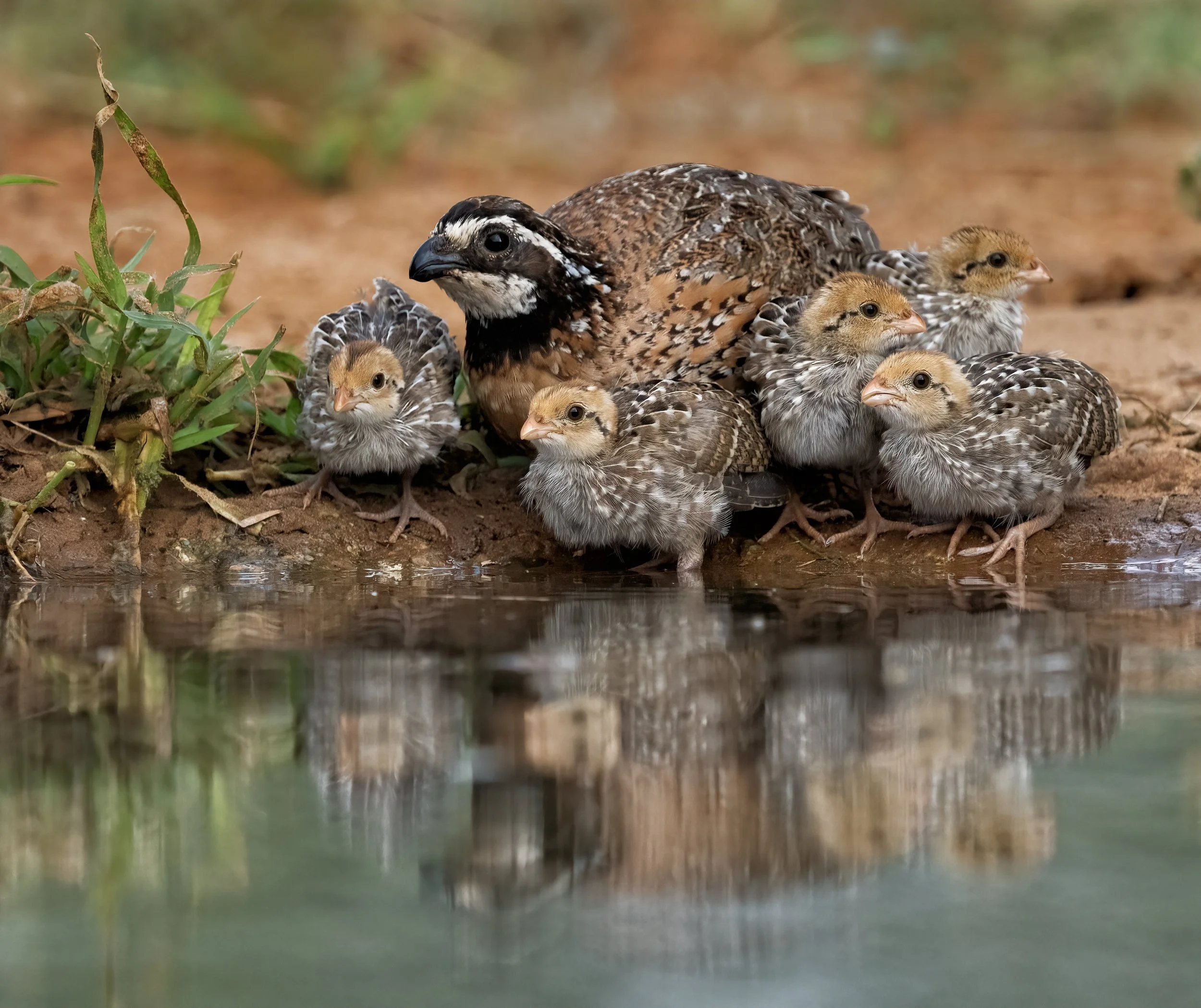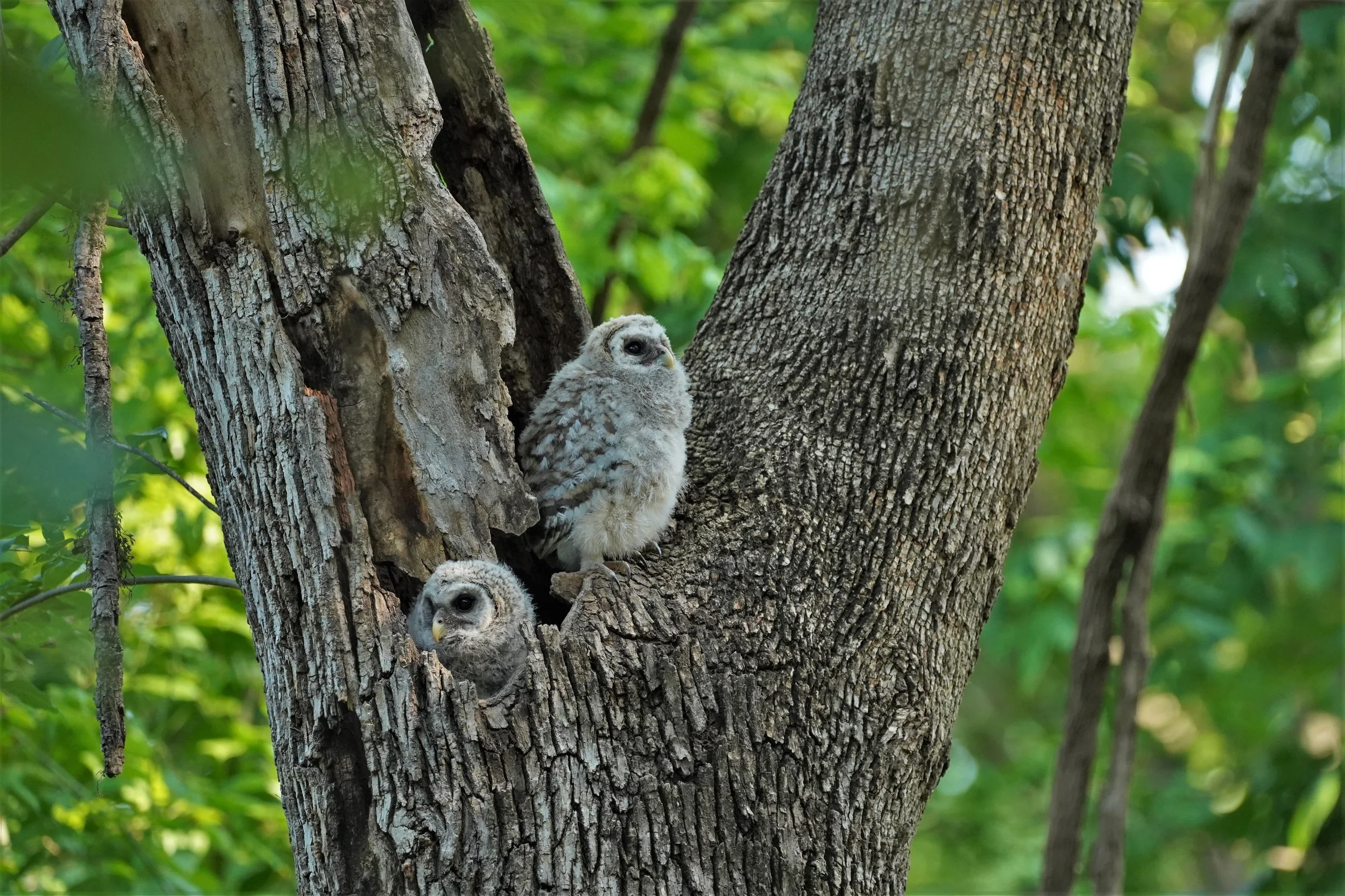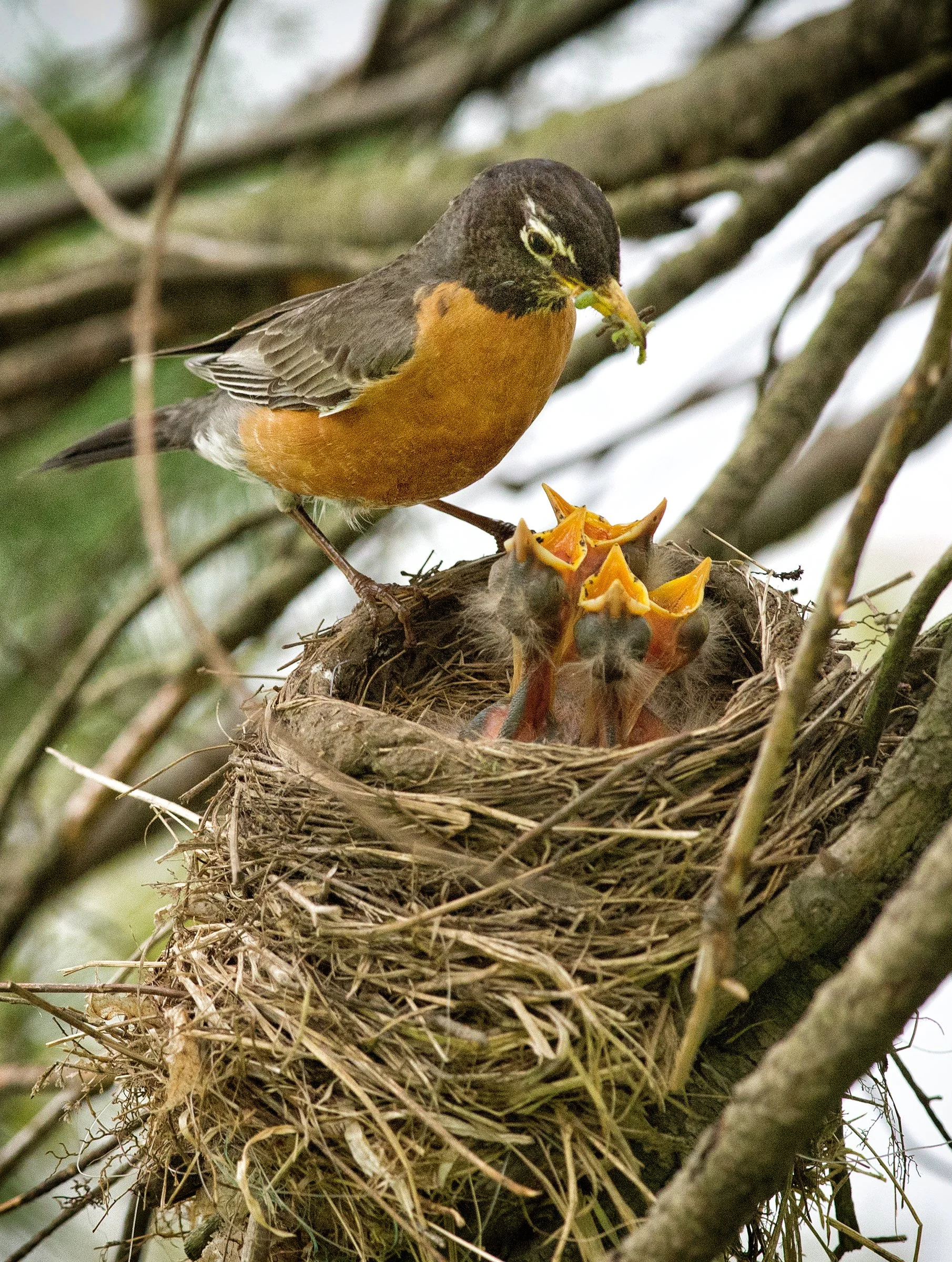Every year baby birds take their first flight, first nibbles, and first steps out of the nest. But not all chicks reach their milestones at the same time. Those that hit the ground running, so to speak, are considered ‘precocial’ – when they hatch, they are covered in down or contour feathers and their eyes are open; some can even find their own food, although they may rely on mom and/or dad for a little while. Altricial birds, on the other hand, are initially entirely dependent on their parent(s) as they are not able to leave the nest.
Why does this happen? It may be driven by a balance between sufficient caloric intake and the type of pressure exerted by predators. Precocial young develop at a faster pace inside the egg than their altricial counterparts, and so they ingest more calories within the eggshell. This requires the female bird to be able to consume enough sustenance to lay such energy-rich eggs. On the contrary, mothers (and fathers) of altricial young have to worry more about finding enough food for their offspring after they have hatched, a time when some altricial chicks grow rapidly from hatchlings to fledglings.
Altricial birds typically dwell in trees while precocial birds prefer the ground, and, in general, species of the former are quicker to master flight. A nest full of weak, helpless hatchlings is at risk of being wiped out in one attack. During this time period of vulnerability, the parents must have the energy to be ready to defend the nest and/or the nest should be well concealed. Conversely, if chicks are mobile and able to find food soon after hatching, there is a much lower risk that an entire brood could be eaten at the same time. Each individual precocial chick, though, may face great danger, especially if it cannot fly.
Common Merganser, female and chicks, Alaska
Beverly McNeil/Audubon Photography Awards
It is important to note, however, that birds are not just precocial or altricial. There are eight levels of development: Precocial 1-4, Semi-Precocial, Semi-Altricial 1-2, and Altricial.
Precocial 1
Summary: Born with contour feathers & eyes open, mobile at hatching, able to feed themselves, parents absent
Species that are ‘Precocial 1’ are born not with down but with contour feathers (the feathers that cover a bird’s body) similar to what adults have. Additionally, from the start their eyes are open, they possess the ability to leave the nest, and they have the capability of feeding themselves. There is also no parental care at all. Megapodes, chicken-like birds such as Brush Turkeys and Malleefowl, fall into this category; they are entirely independent from birth. No megapodes are found in Chicago, however, or in North America - they reside in Australasia.
Precocial 2
Summary: Born with down & eyes open, mobile at hatching, shadow parents to find own food
Wood Duck, female and chick, Harford, Maryland
Joe Subolefsky/Audubon Photography Awards
Parents are present for ‘Precocial 2’ and onwards; chicks in this class do follow adults around as they search for food, although they are able to feed themselves. Ducks are a common example of Precocial 2 birds, and along with the ability to self-nourish, are ready to swim soon after hatching. Wood Ducks are cavity nesters who take an extra step – or leap – to get to the water. One to four days after hatching, they will jump out of their nest, possibly 65+ feet from the ground, to join their mother on a walk to a nearby body of water. If you happen to see this, don’t worry – they are too light for the fall to hurt them. Hooded Mergansers and Common Goldeneye are examples of other ducks with fearless progeny who think nothing of leaping down from far above the ground to get to a pond or lake.
This might not be a surprise for anyone following the Piping Plovers at Montrose Beach, but plovers are also ‘Precocial 2’ birds! In less than a day after hatching, they are able to run and forage. Mom and dad help by brooding their young; Piping Plover chicks are not able to regulate their body temperature and so they rely on their parents to keep warm. They also require their parents to protect them from danger. About ten days in or so, the female bird commonly starts her migration journey south, and the male is left to take care of the young until they are able to fly around 25 days old. When the chicks reach this stage, it’s time for the father bird to head to his wintering grounds. Maybe a week or two later, it is the chicks’ turn to migrate.
Precocial 3
Summary: Born with down & eyes open, mobile at hatching, are shown food by parents
Northern Bobwhite, adult and chicks, Edinburg, Texas
Donald Wuori/Audubon Photography Awards
The offspring of game birds such as turkeys and quail are nearly self-sufficient, although they need some guidance on what’s good to eat. Northern Bobwhite chicks, for instance, are raised by a caring parental unit. For about two weeks they are shielded from the sun and kept warm during chilly nights. If it looks like danger is approaching, one of the adults will pretend to have an injury, e.g. a broken wing, to lure the predator away. Around the two-week mark, the chicks are able to fly and are considered independent.
Precocial 4
Summary: Born with down & eyes open, mobile at hatching, fed by parents
Pied-billed Grebe, adult and chicks, Levee Pond Park, Pierce county, Washington
Jose Mendoza/Audubon Photography Awards
Those that fall under ‘Precocial 4’, such as grebes and rails, are fed initially by their parents. Pied-billed Grebe young stick close to the adults in the family. One may see a slew of grebe chicks jockeying for a spot on a parent’s back; it’s a way to keep warm and prevent overexertion as they are not hardy swimmers initially. As the young grebes become more resilient, they start spending less time sitting and more time swimming in the water. It takes about 30 days for a Pied-billed Grebe to develop the capability of flight.
Semi-precocial
Summary: Born with down & eyes open, mobile at hatching but stay in nest area, fed by parents
Common Tern, adult and chicks, Lido Beach, New York
Scott Dere/Audubon Photography Awards
The young of gulls and terns, examples of semi-precocial subfamilies, aren’t about to catch their own food as they hang around the nest. Herring Gull chicks do not leave the nesting area for 2 or 3 weeks even though physically they can, and they expect meals to be supplied by their parents for several months. In fact, mom and dad are even responsible for mealtime several weeks after the chicks take flight. Juveniles will venture out on their own generally around three months, although some will stick around their family for longer.
Semi-altricial 1
Summary: Born with down & eyes open, immobile at hatching, fed by parents
Green Heron, adult and chicks
Erin Smith/Audubon Photography Awards
Now we move from the realm of precocial to altricial. Species that are ‘Semi-altricial 1’ are not mobile or self-sufficient from hatching day, although they come out covered in fuzzy down with eyes open. Green Heron young are fed via regurgitation; it generally requires around three weeks for them to begin flying, and the parents are present a little while longer for feeding before their offspring become independent after 30-35 days.
Semi-altricial 2
Summary: Born with down & eyes closed, immobile at hatching, fed by parents
Barred Owl, chicks, Colleyville Nature Center, Texas
Tanuja Reddy/Audubon Photography Awards
Owls are an example of birds that are ‘Semi-altricial 2’; the main difference between this category and simply ‘Altricial’ is that birds in the latter grouping hatch featherless. Barred Owls come covered in a coating of white down feathers. They are fed for three or four months, although they are able to leave the nest after about one to two months. They are strong enough to climb out of their nest, and hop to and sit on branches. It takes about a fourth of a year for a Barred Owl to master flight.
Altricial
Summary: Born naked & eyes closed, immobile at hatching, fed by parents
American Robin, adult and chicks
Tom Warren/Audubon Photography Awards
Blind and naked, baby altricial birds are quite defenseless when they finally break out of their egg. Because they cannot leave the nest and find food, they wait for their meals to come to them. Examples of altricial birds include passerines, woodpeckers, and hummingbirds. Rock Doves are altricial as well; baby pigeons are known as squabs during their first 30 days, which is about how long it takes for them to leave the nest. During this time, a squab is fed crop milk, created in the lining of their parents’ throats, and seed as they get older. This nourishment is essentially vomited from the mother or father to the child. However, even when a young pigeon transitions to a fledgling and leaves the nest, it will still try to score a meal from its guardians for a few weeks before learning to feed itself around week 7.
Birds are highly diverse, and their method of development is just another fascinating way they distinguish themselves from one another. It’s so interesting to see how a bird moves from hatchling to adult! On your next birding trip, if you are lucky enough to spot a baby bird, check for signs of precociality or altriciality. See if it’s depending on its parent or well along on its own from the start. And if you find a fledgling by itself and want to help it, be very certain that its parent is not nearby - chances are it’s having a supervised adventure. In the event a young bird looks like it’s in trouble, please contact a local wildlife rehabilitation center for next steps.
Great Black-backed Gull, adult and chick, Larchmont, New York
Michael Weinstein/Audubon Photography Awards
Sources:
General Data:
Feather Evolution from Precocial to Altricial Birds - PMC
Altricial-precocial spectra in animal kingdom - ScienceDirect
Precocial versus Altricial Development – Maine Birds
Young Bird Development and Parental Care:… | Summer 2023 | Articles | Feathers and Flight
Precocial 1:
Megapodiidae - Megapodes - Birds of the World
Everything You Need To Know About Feathers
Precocial 2:
Wood Duck Jump Day - Wisconsin Waterfowl Association
Wood Ducklings Jump, But Don't Worry, They Bounce
Wood Duck - Big Thicket National Preserve (U.S. National Park Service)
Hooded Mergansers: Crested Divers - Marshy Point Nature Center
Common Goldeneye Overview, All About Birds, Cornell Lab of Ornithology
Make Way For Chicks! - Maine Audubon
PIPING PLOVER Frequently Asked Questions
Piping Plover | Audubon Field Guide
Outdoor Illinois Journal: Plovers All Over: The winter life of Great Lakes piping plovers
Precocial 3:
Life History – National Bobwhite & Grassland Initiative
Colinus virginianus (northern bobwhite)
6 cool facts about northern bobwhite quail | Department of Natural Resources
A Quail of a Tale | Missouri Department of Conservation
Precocial 4:
Pied-billed Grebe - NH Audubon
Pied-billed Grebe Guide - New York Natural Heritage Program
Pied-billed Grebe Overview, All About Birds, Cornell Lab of Ornithology
Pied-Billed Grebe Bird Facts - Podilymbus podiceps - A-Z Animals
Pied-billed Grebe | Audubon Field Guide
Semi-Precocial:
Herring Gull | Audubon Field Guide
Semi-Altricial 1:
Green Heron: The Recluse of the Heron Family
Green Heron Life History, All About Birds, Cornell Lab of Ornithology
Green Heron | Audubon Field Guide
Butorides virescens (Green Heron)
Green Heron - Butorides virescens - NatureWorks
Semi-Altricial 2:
Breeding - Barred Owl - Strix varia - Birds of the World
Barred Owl Fledgling Leaves its Nest
Altricial:
Mosco, Rosemary. A Pocket Guide to Pigeon Watching: Getting to Know the World's Most Misunderstood Bird. Workman Publishing, 2021.
Conclusion










